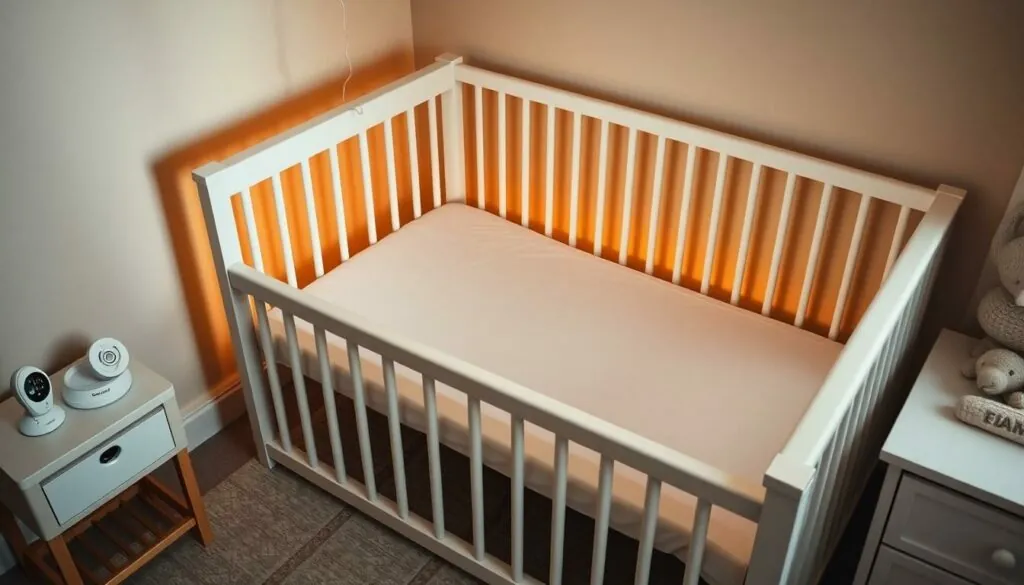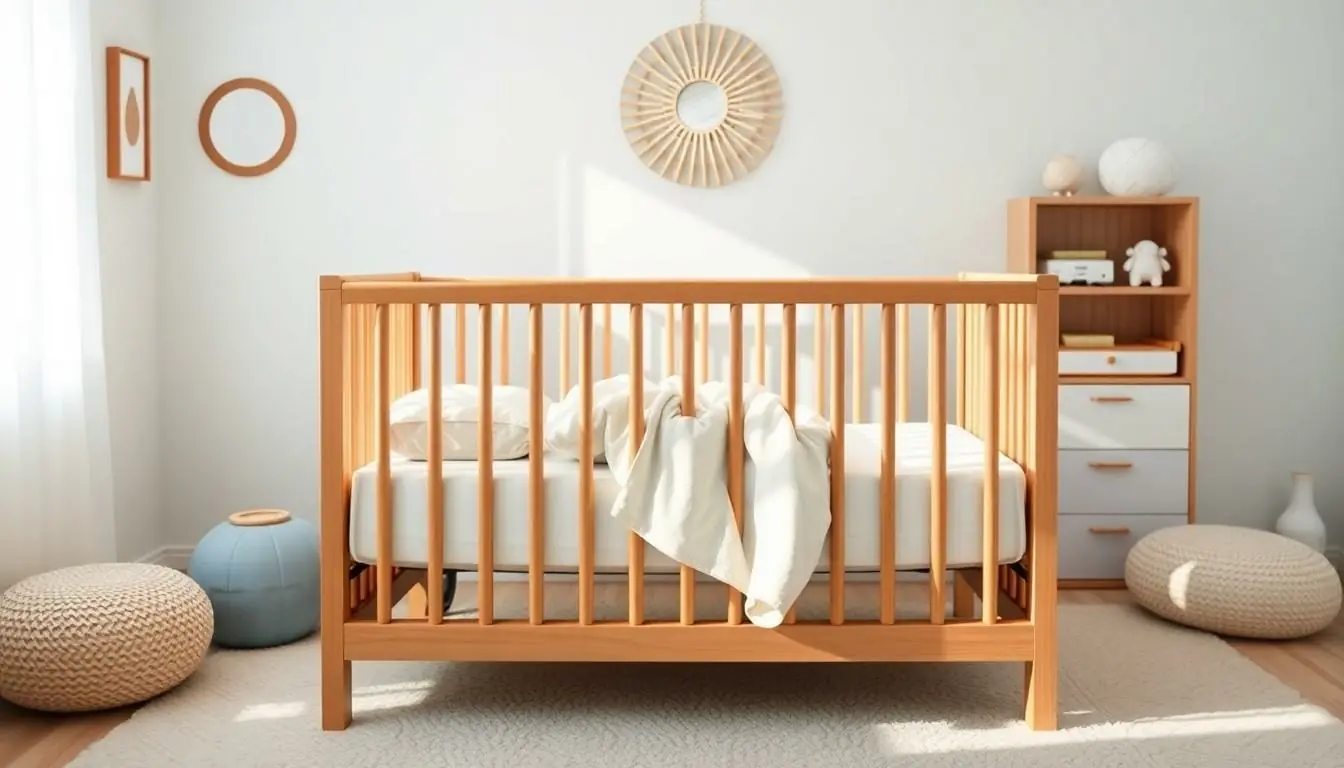Bringing home a tiny bundle of joy comes with countless questions and one big dilemma: where should that precious little one sleep? While many parents might feel tempted to keep their newborn in their arms 24/7 (those baby snuggles are irresistible), it’s essential to establish safe sleeping habits from day one.
The American Academy of Pediatrics (AAP) has clear guidelines about newborn sleep safety, and yes – cribs make the list of approved sleeping spaces. But before you rush to set up that beautiful nursery you’ve been dreaming about, there are some important factors to consider. From crib safety standards to the right time to transition your baby, making informed decisions about your newborn’s sleep environment will help everyone rest easier at night.
Table of Contents
ToggleWhen Can Newborns Safely Sleep in a Crib
Newborns sleep safely in a crib from their first day of life when following proper safety guidelines. The American Academy of Pediatrics (AAP) confirms that cribs provide a secure sleeping environment for infants throughout their entire first year.
Safe crib sleeping requires these essential conditions:
- A firm flat mattress with no gaps between the mattress edges
- Fitted sheets designed specifically for crib mattresses
- No pillows blankets bumpers or toys inside the crib
- Room temperature maintained between 68-72°F (20-22°C)
The CDC provides specific age-based safety recommendations:
| Age Range | Safety Measures |
|---|---|
| 0-3 months | Back sleeping position only swaddle optional |
| 4-6 months | Back sleeping position transition from swaddle |
| 6-12 months | Back sleeping position sleep sack if needed |
Parents notice these readiness signs for crib sleeping:
- Baby maintains a consistent body temperature
- Demonstrates steady head control
- Shows regular sleep patterns
- Reaches appropriate weight milestones
Location matters for crib placement:
- Within arm’s reach of parents’ bed for 0-6 months
- Away from windows cords or hanging objects
- Clear of furniture that babies might use for climbing
- Protected from direct sunlight or heating vents
The transition succeeds more smoothly when parents establish a consistent bedtime routine including feeding diaper changes gentle rocking or quiet singing. Babies adapt to crib sleeping gradually taking 3-7 days to become comfortable in their new sleep space.
Setting Up a Safe Sleep Environment
Creating a secure sleep environment involves following established safety guidelines from the Consumer Product Safety Commission (CPSC) and using appropriate bedding items.
Crib Safety Standards
Modern cribs meet stringent CPSC regulations enacted in 2011 that set specific requirements for slat spacing, mattress fit and hardware durability. The requirements include:
- Slats spaced no more than 2.375 inches apart to prevent head entrapment
- No drop-side rails due to safety hazards
- Sturdy corner posts with heights under 1/16 inch
- Secure hardware that prevents loosening
- Lead-free finish and non-toxic materials
- Proper mattress fit with gaps under 2 finger widths
- Impact-tested construction that withstands 45 pounds of weight
Essential Crib Bedding Items
A safe crib setup requires minimal bedding items to reduce suffocation risks. The core elements include:
- Firm crib mattress that maintains shape
- Waterproof mattress cover
- 2-3 fitted crib sheets made of breathable cotton
- Wearable blankets or sleep sacks for warmth
Unsafe items to remove:
- Loose blankets
- Crib bumpers
- Pillows or cushions
- Stuffed animals
- Positioning devices
- Decorative bedding sets
Baby’s sleep space remains clear except for the mattress and fitted sheet, following AAP recommendations for reducing SIDS risk.
Transitioning from Bassinet to Crib
Moving a baby from a bassinet to a crib marks a significant milestone in their development. This transition typically occurs between 3-6 months of age, depending on the baby’s growth and sleeping patterns.
Signs Your Baby is Ready
Physical growth indicators signal when babies outgrow their bassinets. A baby reaching 15 pounds or half the bassinet’s weight limit indicates readiness for a crib transition. Additional signs include:
- Rolling over independently in their sleep
- Bumping against bassinet walls while moving
- Sitting up unassisted
- Outgrowing the bassinet length
- Showing increased awareness of surroundings
- Demonstrating consistent sleep patterns
Making the Move Gradual
A smooth transition requires a methodical approach spread across several days. Key steps include:
- Placing the crib in the same room as the bassinet
- Starting daytime naps in the crib first
- Using the same sleep sack or swaddle from the bassinet
- Maintaining identical white noise settings
- Following the established bedtime routine
- Moving the crib near the parents’ bed
- Ensuring room temperature matches previous sleeping space
Parents notice improved sleep quality in 3-4 nights with consistent implementation of these practices. The familiarity of sleep cues helps babies adapt to their new sleeping environment.
Safe Sleep Practices for Newborns
Safe sleep practices protect newborns from potential risks during rest periods. Following established guidelines from pediatric experts ensures optimal safety for infants during their sleeping hours.
Sleep Position Guidelines
The American Academy of Pediatrics (AAP) recommends placing babies on their backs to sleep for every nap and nighttime rest. This “Back to Sleep” position reduces the risk of Sudden Infant Death Syndrome (SIDS) by 50%. A firm flat surface supports proper breathing and prevents suffocation risks.
Key positioning practices include:
- Placing baby’s feet at the foot of the crib
- Positioning the head uncovered and clear of blankets
- Using sleep sacks instead of loose bedding
- Ensuring baby’s face remains unobstructed
The CDC reports that back sleeping reduces breathing difficulties compared to side or stomach positions. Parents must reposition babies who roll onto their stomachs until they can roll both ways independently, typically around 4-6 months.
Room Temperature and Ventilation
Room temperature significantly impacts infant sleep safety and comfort. The optimal temperature range for a newborn’s sleep environment is 68-72°F (20-22°C). Proper ventilation maintains fresh air circulation and prevents overheating.
Essential environmental controls include:
- Installing a room thermometer to monitor temperature
- Using ceiling fans to improve air circulation
- Opening windows for 15 minutes daily for fresh air
- Maintaining 30-50% humidity levels
- Baby’s chest feels warm but not hot
- Nape of neck remains dry
- Hands and feet maintain normal color
- Breathing appears easy and regular
Common Crib Safety Concerns
Crib safety remains a critical factor in protecting newborns during sleep. The Consumer Product Safety Commission reports over 10,000 crib-related injuries annually, highlighting the importance of addressing common safety concerns.
Preventing SIDS Risk
SIDS prevention starts with creating a bare crib environment. The CDC reports that removing loose bedding reduces SIDS risk by 50%. Essential safety measures include:
- Installing a carbon monoxide detector within 15 feet of the crib
- Maintaining room temperature at 68-72°F (20-22°C)
- Positioning the crib away from windows cords blinds
- Using a flat firm mattress without added padding
- Removing all toys stuffed animals pillows from the crib
The AAP recommends exclusive back sleeping for all sleep periods. Supervised tummy time occurs only during awake periods to promote muscle development.
Proper Mattress Fit
A properly fitted mattress creates a secure sleep environment. The CPSC mandates these specific measurements:
| Measurement | Requirement |
|---|---|
| Maximum gap between mattress edge crib wall | 2 finger width (0.5 inches) |
| Minimum mattress depth | 5 inches |
| Standard crib mattress size | 27.25 x 51.25 inches |
The mattress sits flat against the crib base without gaps or spaces. Parents check mattress fit by attempting to insert two fingers between the mattress edge crib side – anything larger indicates an unsafe fit requiring immediate replacement.
Sleep Schedule for Newborn Babies
Newborns sleep between 14-17 hours daily in short cycles of 2-4 hours. Sleep patterns during the first months follow a consistent schedule:
| Age | Total Sleep Hours | Number of Naps | Night Sleep Duration |
|---|---|---|---|
| 0-2 months | 14-17 hours | 4-5 naps | 8-9 hours |
| 2-4 months | 12-16 hours | 3-4 naps | 9-10 hours |
Morning naps typically start 1-2 hours after waking. These naps range from 30 minutes to 2 hours based on individual sleep cycles.
Common sleep windows for newborns include:
- First nap: 8:00-9:30 AM
- Second nap: 11:00 AM-12:30 PM
- Third nap: 2:00-3:30 PM
- Fourth nap: 5:00-6:30 PM
- Bedtime: 8:00-9:00 PM
Sleep cues in newborns appear as:
- Rubbing eyes
- Pulling ears
- Decreased activity
- Yawning frequently
- Becoming fussy
Parents recognize sleep patterns through:
- Tracking feeding times
- Observing wake windows
- Noting sleep duration
- Recording nap frequency
- Monitoring nighttime wakings
The American Academy of Sleep Medicine confirms these patterns establish circadian rhythms by 3-4 months. Babies transition to longer sleep periods at night once their internal clock develops.
Conclusion
Cribs provide a safe sleeping environment for newborns when parents follow proper safety guidelines. A bare crib with a firm mattress and fitted sheet offers the ideal space for healthy sleep development. Parents should place their baby on their back to sleep and keep the crib free from loose bedding toys and other hazards.
With consistent routines and patience newborns can successfully transition to crib sleeping. Following safety recommendations from trusted organizations like the AAP and CPSC ensures babies get the rest they need while staying protected. Creating and maintaining these safe sleep practices from day one sets the foundation for healthy sleep habits that will benefit both baby and parents.






